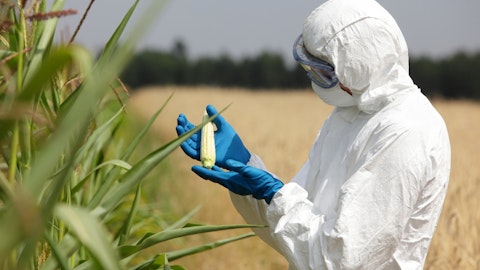But they’re all vaccine naive. So that’s a very important data set. And that is key I think, to the new data coming in April of this year. Now, the second question around differentiation, perhaps will relate to, to the dose. And here there’s a growing interest in the notion of multi pathogen vaccines. And the one that’s much talked about is the idea of a single vaccine that protects people over 60 against three different viruses, RSV, influenza and SARS-CoV-2, so can I put all three together? And obviously the question is, what will the benefit, in other words immunogenicity look like? And then what will the reactogenicity look like, how well tolerated or such a vaccine be. And the challenge with some of the products is that, at the full dose, there’s a clearly acceptable amount of reactogenicity.
But if I drop the dose, perhaps by a third, to allow three equivalent, or three different pathogens in the same product, dropping the dose actually leads to meaningfully reduced immunogenicity, which obviously, is not what you want, that’s definitely moving in the wrong direction. And so dosing and immuno reactor ratio becomes very important for the platform. And this is where self-amplifying mRNA may have an advantage because it does make copies of itself, which permits relatively low doses to be used, as we’ve shown. And so the interesting question becomes, do we see good immunogenicity at low doses, as low as three or five micrograms, such that one could think about putting three of those doses together into a 50 microgram product with acceptable reactogenicity.
And I think the immunoreactive profile of samRNA looks a bit different from what we’ve seen so far from mRNA, that just the numbers are different. And of course, again, be looking out for those data in this data set coming in ECCMID. So those are two potential points of key differentiation for self-amplifying mRNA versus mRNA. And I think that’s what you should be looking for.
Arthur He: That’s awesome. Thanks for the color Andrew. And my second question actually alluded to the, the multi agent vaccine. So in your plan, are you guys still pursuing COVID through RSV, vaccine by yourself? Or — you were only consumed with a partner?
Andrew Allen: We’re interested in that product concept for sure. And there are obviously quite a few things, we can do it at research level. We’re well equipped to do those. And obviously, if we have good data, then that might be something apart, potentially would be interested in. So certainly we are we are pursuing that product class internally, initially at the research level as you as you might anticipate.
Arthur He: Got you. Thanks for taking my question and congrats on the progress.
Andrew Allen: Thank you.
Operator: Our next question comes from the line of Corinne Jenkins with Goldman Sachs. Please proceed.
Corinne Jenkins: Yes. Good afternoon, everyone. Maybe just a couple from me with this fourth quarter update for GRANITE. Just how many patients should we be looking for? And can you talk I know we don’t have a great sense of the magnitude of ctDNA benefit. But as you think about clinical thresholds to move forward with the program, what would be your best case expectation? What would make you really excited? And what would be kind of the last exciting outcome?
Andrew Allen: Yes, thanks, Corrine. So the sample size for the phase 2 component is 80. And obviously, the study is enrolling well, and we anticipate a data from a meaningful fraction of those subjects at year end. And the key here is that you need four months data. So that’s the constraint on this total quantity of data this year, which is the requirement for four months data, and the reason we need four month data is that we have observed even in third line, and we’ve shown these, these data, we observe pseudoprogression, not infrequently, which means that markers can be going up at the six, eight week time point. And scans can show lesion expansion at that time point, which actually is pseudoprogression. Because it then subsequently everything comes down.



